Key Problems and Stakeholders in Clinical Healthcare Inc.
VerifiedAdded on 2023/06/14
|14
|3653
|100
AI Summary
This article identifies the key problems faced by Clinical Healthcare Inc. including delay in administering treatment, unreliable system, and aged infrastructure. The stakeholders involved are also discussed, including employees and partners. Possible models, tools, and techniques that can be used to analyze the current system are suggested.
Contribute Materials
Your contribution can guide someone’s learning journey. Share your
documents today.
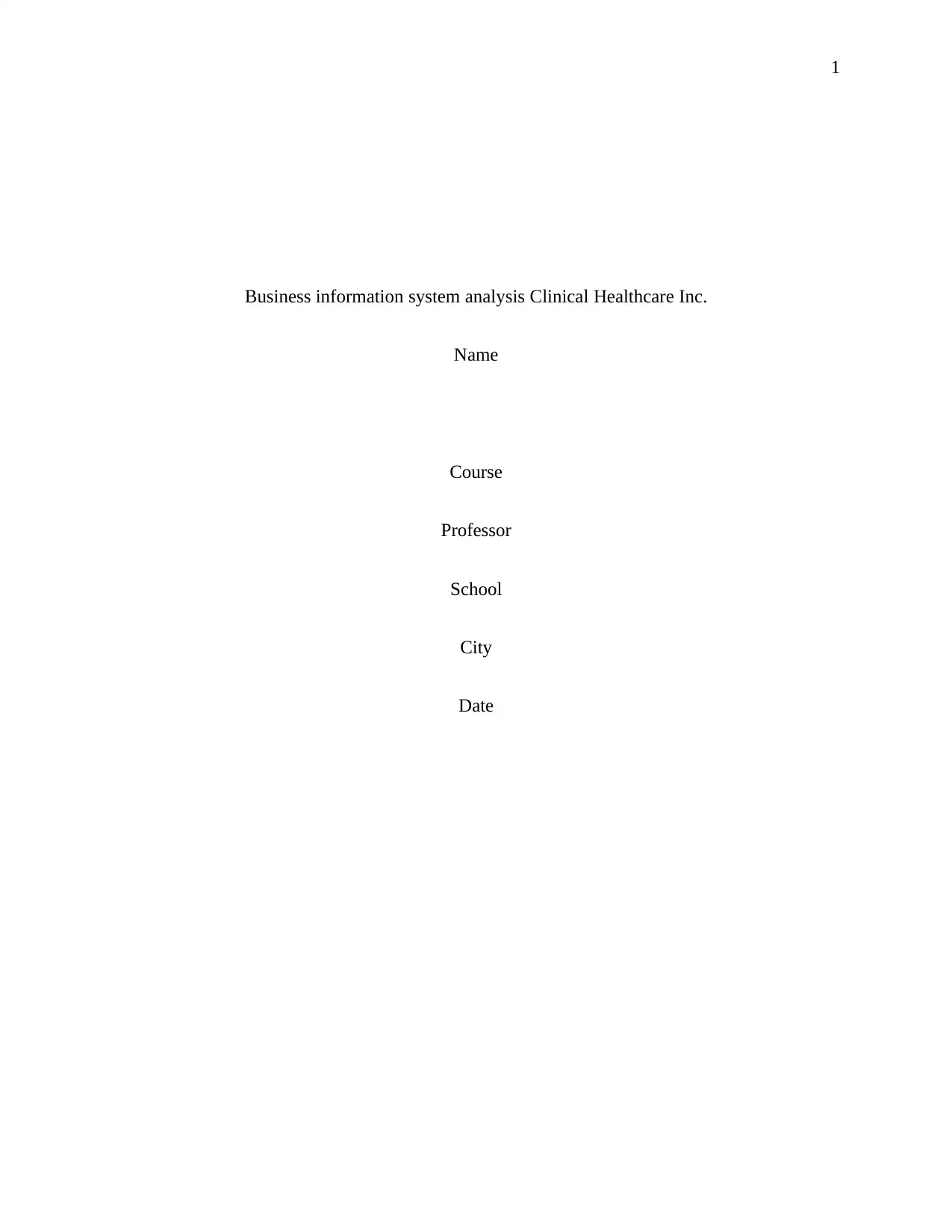
1
Business information system analysis Clinical Healthcare Inc.
Name
Course
Professor
School
City
Date
Business information system analysis Clinical Healthcare Inc.
Name
Course
Professor
School
City
Date
Secure Best Marks with AI Grader
Need help grading? Try our AI Grader for instant feedback on your assignments.
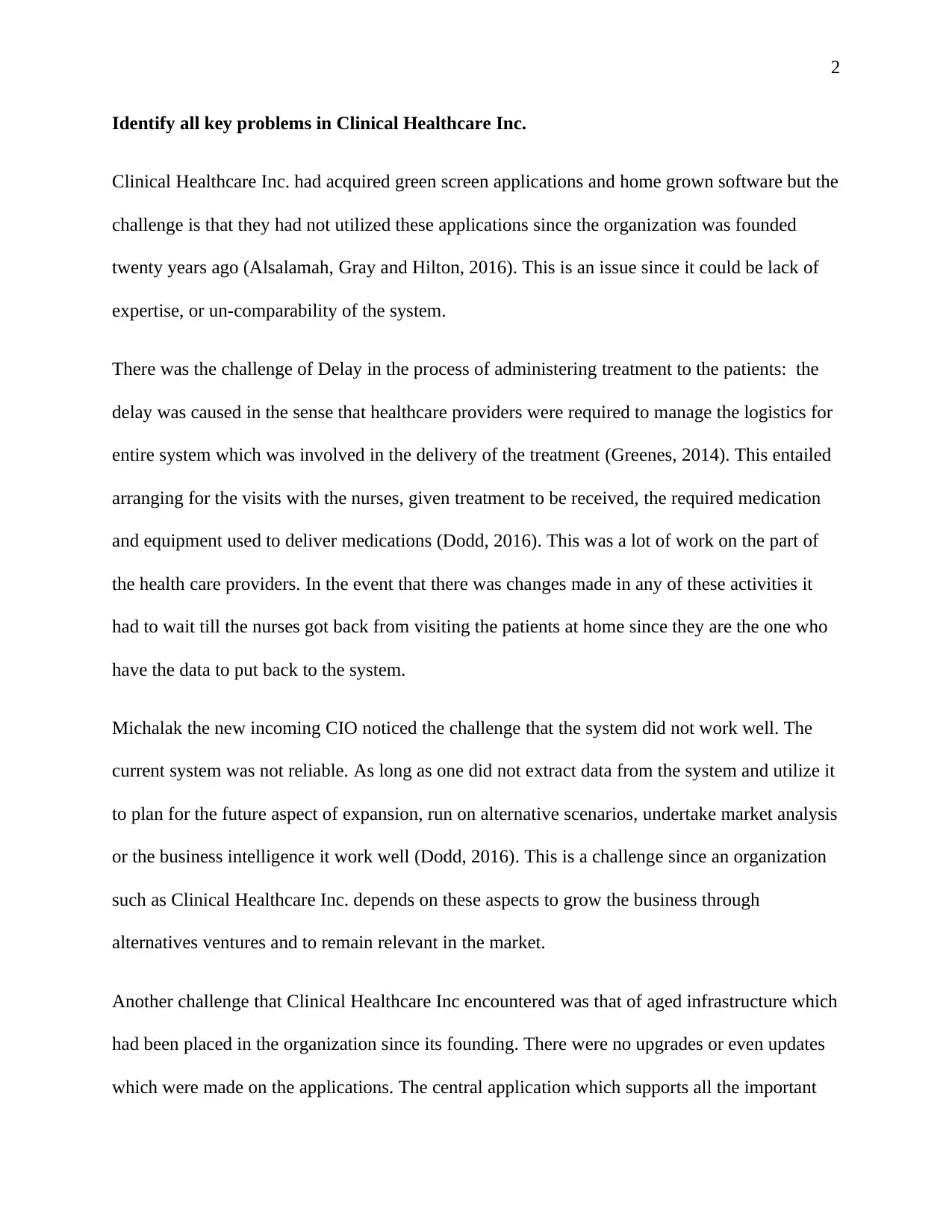
2
Identify all key problems in Clinical Healthcare Inc.
Clinical Healthcare Inc. had acquired green screen applications and home grown software but the
challenge is that they had not utilized these applications since the organization was founded
twenty years ago (Alsalamah, Gray and Hilton, 2016). This is an issue since it could be lack of
expertise, or un-comparability of the system.
There was the challenge of Delay in the process of administering treatment to the patients: the
delay was caused in the sense that healthcare providers were required to manage the logistics for
entire system which was involved in the delivery of the treatment (Greenes, 2014). This entailed
arranging for the visits with the nurses, given treatment to be received, the required medication
and equipment used to deliver medications (Dodd, 2016). This was a lot of work on the part of
the health care providers. In the event that there was changes made in any of these activities it
had to wait till the nurses got back from visiting the patients at home since they are the one who
have the data to put back to the system.
Michalak the new incoming CIO noticed the challenge that the system did not work well. The
current system was not reliable. As long as one did not extract data from the system and utilize it
to plan for the future aspect of expansion, run on alternative scenarios, undertake market analysis
or the business intelligence it work well (Dodd, 2016). This is a challenge since an organization
such as Clinical Healthcare Inc. depends on these aspects to grow the business through
alternatives ventures and to remain relevant in the market.
Another challenge that Clinical Healthcare Inc encountered was that of aged infrastructure which
had been placed in the organization since its founding. There were no upgrades or even updates
which were made on the applications. The central application which supports all the important
Identify all key problems in Clinical Healthcare Inc.
Clinical Healthcare Inc. had acquired green screen applications and home grown software but the
challenge is that they had not utilized these applications since the organization was founded
twenty years ago (Alsalamah, Gray and Hilton, 2016). This is an issue since it could be lack of
expertise, or un-comparability of the system.
There was the challenge of Delay in the process of administering treatment to the patients: the
delay was caused in the sense that healthcare providers were required to manage the logistics for
entire system which was involved in the delivery of the treatment (Greenes, 2014). This entailed
arranging for the visits with the nurses, given treatment to be received, the required medication
and equipment used to deliver medications (Dodd, 2016). This was a lot of work on the part of
the health care providers. In the event that there was changes made in any of these activities it
had to wait till the nurses got back from visiting the patients at home since they are the one who
have the data to put back to the system.
Michalak the new incoming CIO noticed the challenge that the system did not work well. The
current system was not reliable. As long as one did not extract data from the system and utilize it
to plan for the future aspect of expansion, run on alternative scenarios, undertake market analysis
or the business intelligence it work well (Dodd, 2016). This is a challenge since an organization
such as Clinical Healthcare Inc. depends on these aspects to grow the business through
alternatives ventures and to remain relevant in the market.
Another challenge that Clinical Healthcare Inc encountered was that of aged infrastructure which
had been placed in the organization since its founding. There were no upgrades or even updates
which were made on the applications. The central application which supports all the important
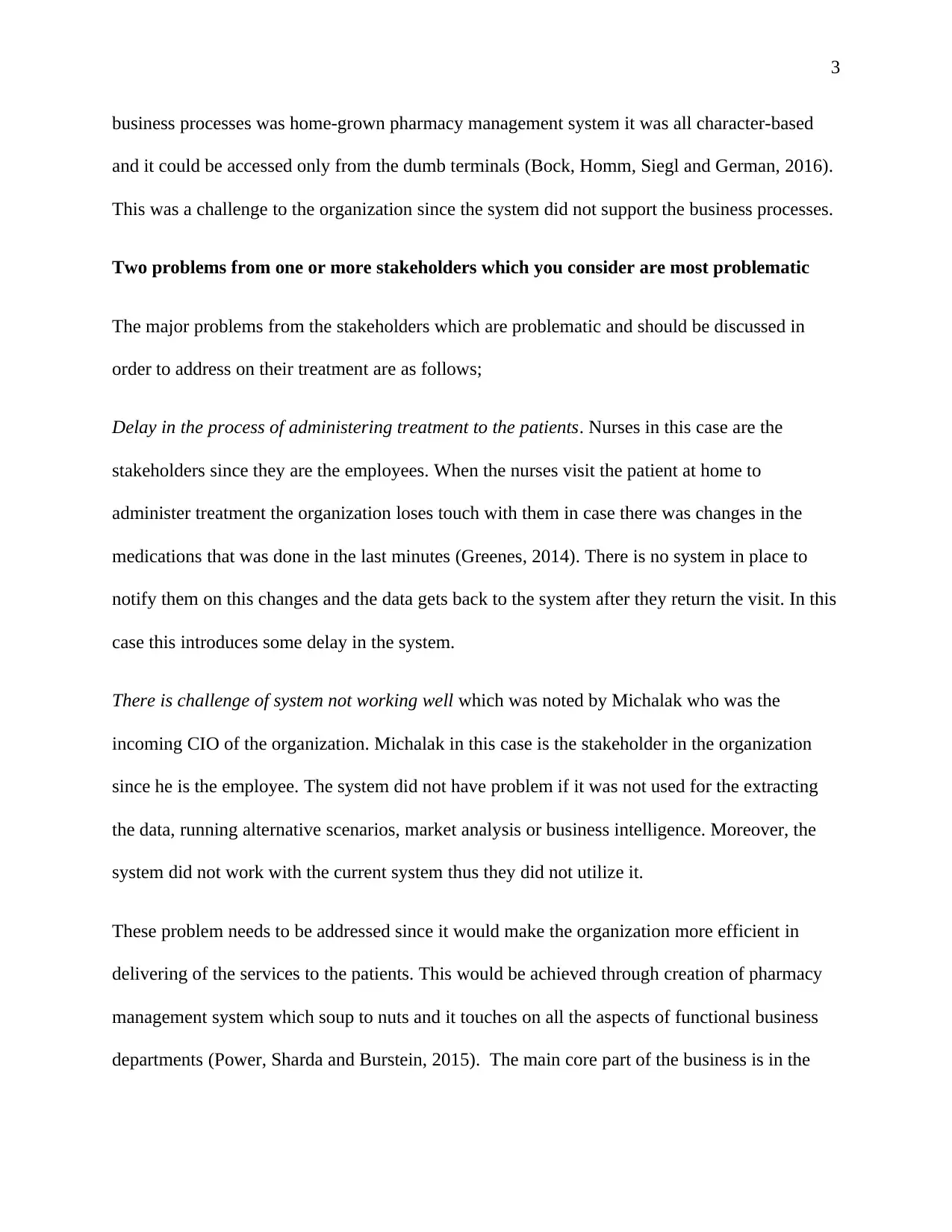
3
business processes was home-grown pharmacy management system it was all character-based
and it could be accessed only from the dumb terminals (Bock, Homm, Siegl and German, 2016).
This was a challenge to the organization since the system did not support the business processes.
Two problems from one or more stakeholders which you consider are most problematic
The major problems from the stakeholders which are problematic and should be discussed in
order to address on their treatment are as follows;
Delay in the process of administering treatment to the patients. Nurses in this case are the
stakeholders since they are the employees. When the nurses visit the patient at home to
administer treatment the organization loses touch with them in case there was changes in the
medications that was done in the last minutes (Greenes, 2014). There is no system in place to
notify them on this changes and the data gets back to the system after they return the visit. In this
case this introduces some delay in the system.
There is challenge of system not working well which was noted by Michalak who was the
incoming CIO of the organization. Michalak in this case is the stakeholder in the organization
since he is the employee. The system did not have problem if it was not used for the extracting
the data, running alternative scenarios, market analysis or business intelligence. Moreover, the
system did not work with the current system thus they did not utilize it.
These problem needs to be addressed since it would make the organization more efficient in
delivering of the services to the patients. This would be achieved through creation of pharmacy
management system which soup to nuts and it touches on all the aspects of functional business
departments (Power, Sharda and Burstein, 2015). The main core part of the business is in the
business processes was home-grown pharmacy management system it was all character-based
and it could be accessed only from the dumb terminals (Bock, Homm, Siegl and German, 2016).
This was a challenge to the organization since the system did not support the business processes.
Two problems from one or more stakeholders which you consider are most problematic
The major problems from the stakeholders which are problematic and should be discussed in
order to address on their treatment are as follows;
Delay in the process of administering treatment to the patients. Nurses in this case are the
stakeholders since they are the employees. When the nurses visit the patient at home to
administer treatment the organization loses touch with them in case there was changes in the
medications that was done in the last minutes (Greenes, 2014). There is no system in place to
notify them on this changes and the data gets back to the system after they return the visit. In this
case this introduces some delay in the system.
There is challenge of system not working well which was noted by Michalak who was the
incoming CIO of the organization. Michalak in this case is the stakeholder in the organization
since he is the employee. The system did not have problem if it was not used for the extracting
the data, running alternative scenarios, market analysis or business intelligence. Moreover, the
system did not work with the current system thus they did not utilize it.
These problem needs to be addressed since it would make the organization more efficient in
delivering of the services to the patients. This would be achieved through creation of pharmacy
management system which soup to nuts and it touches on all the aspects of functional business
departments (Power, Sharda and Burstein, 2015). The main core part of the business is in the
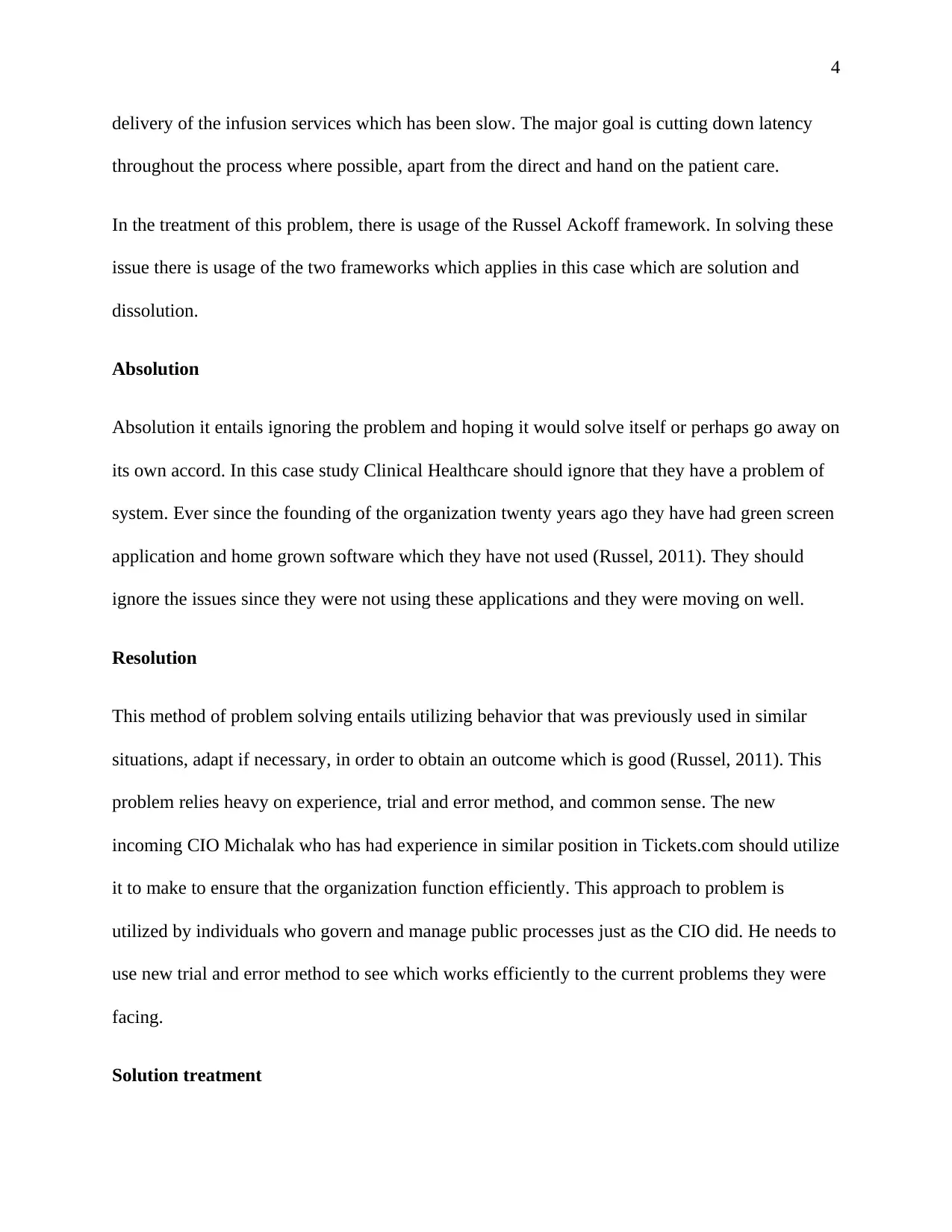
4
delivery of the infusion services which has been slow. The major goal is cutting down latency
throughout the process where possible, apart from the direct and hand on the patient care.
In the treatment of this problem, there is usage of the Russel Ackoff framework. In solving these
issue there is usage of the two frameworks which applies in this case which are solution and
dissolution.
Absolution
Absolution it entails ignoring the problem and hoping it would solve itself or perhaps go away on
its own accord. In this case study Clinical Healthcare should ignore that they have a problem of
system. Ever since the founding of the organization twenty years ago they have had green screen
application and home grown software which they have not used (Russel, 2011). They should
ignore the issues since they were not using these applications and they were moving on well.
Resolution
This method of problem solving entails utilizing behavior that was previously used in similar
situations, adapt if necessary, in order to obtain an outcome which is good (Russel, 2011). This
problem relies heavy on experience, trial and error method, and common sense. The new
incoming CIO Michalak who has had experience in similar position in Tickets.com should utilize
it to make to ensure that the organization function efficiently. This approach to problem is
utilized by individuals who govern and manage public processes just as the CIO did. He needs to
use new trial and error method to see which works efficiently to the current problems they were
facing.
Solution treatment
delivery of the infusion services which has been slow. The major goal is cutting down latency
throughout the process where possible, apart from the direct and hand on the patient care.
In the treatment of this problem, there is usage of the Russel Ackoff framework. In solving these
issue there is usage of the two frameworks which applies in this case which are solution and
dissolution.
Absolution
Absolution it entails ignoring the problem and hoping it would solve itself or perhaps go away on
its own accord. In this case study Clinical Healthcare should ignore that they have a problem of
system. Ever since the founding of the organization twenty years ago they have had green screen
application and home grown software which they have not used (Russel, 2011). They should
ignore the issues since they were not using these applications and they were moving on well.
Resolution
This method of problem solving entails utilizing behavior that was previously used in similar
situations, adapt if necessary, in order to obtain an outcome which is good (Russel, 2011). This
problem relies heavy on experience, trial and error method, and common sense. The new
incoming CIO Michalak who has had experience in similar position in Tickets.com should utilize
it to make to ensure that the organization function efficiently. This approach to problem is
utilized by individuals who govern and manage public processes just as the CIO did. He needs to
use new trial and error method to see which works efficiently to the current problems they were
facing.
Solution treatment
Secure Best Marks with AI Grader
Need help grading? Try our AI Grader for instant feedback on your assignments.
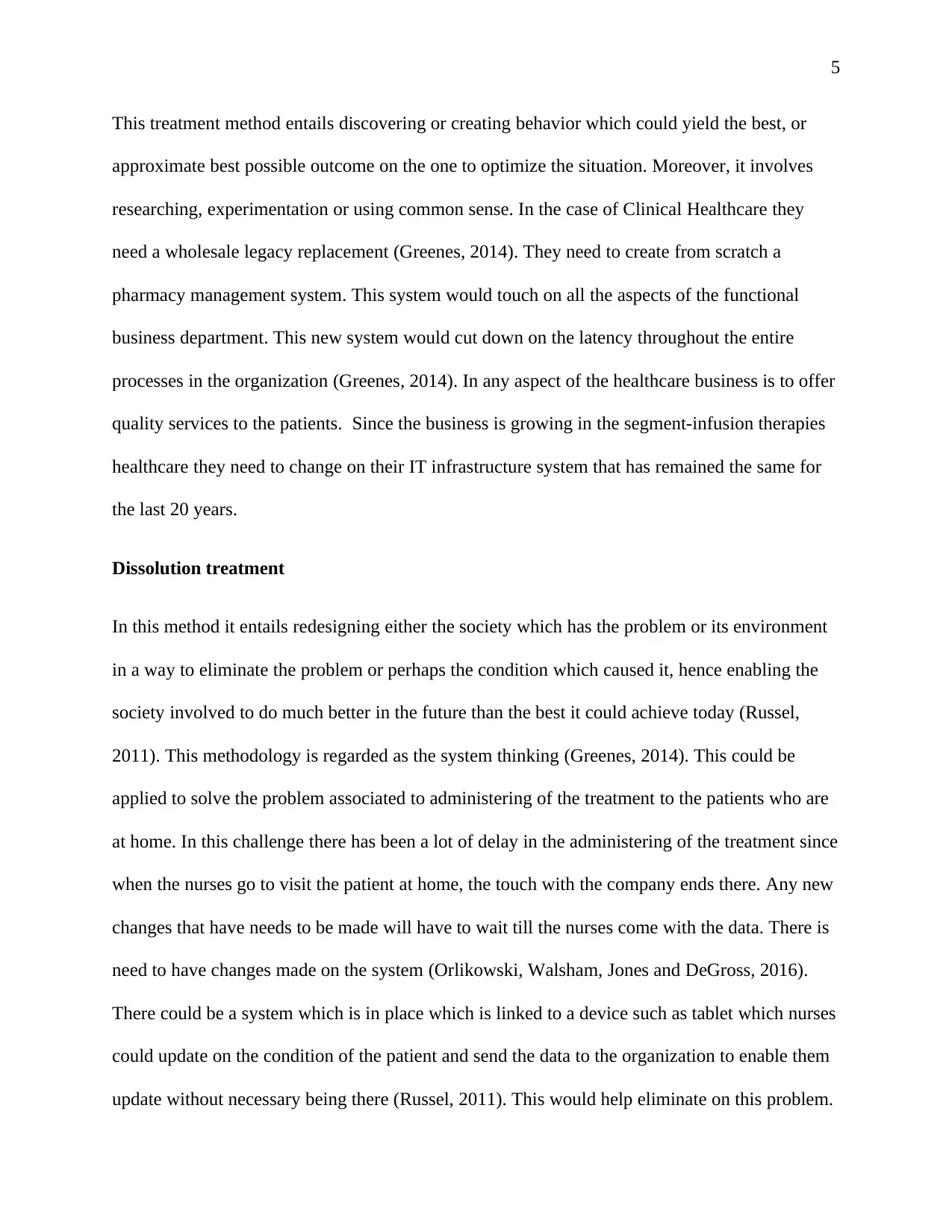
5
This treatment method entails discovering or creating behavior which could yield the best, or
approximate best possible outcome on the one to optimize the situation. Moreover, it involves
researching, experimentation or using common sense. In the case of Clinical Healthcare they
need a wholesale legacy replacement (Greenes, 2014). They need to create from scratch a
pharmacy management system. This system would touch on all the aspects of the functional
business department. This new system would cut down on the latency throughout the entire
processes in the organization (Greenes, 2014). In any aspect of the healthcare business is to offer
quality services to the patients. Since the business is growing in the segment-infusion therapies
healthcare they need to change on their IT infrastructure system that has remained the same for
the last 20 years.
Dissolution treatment
In this method it entails redesigning either the society which has the problem or its environment
in a way to eliminate the problem or perhaps the condition which caused it, hence enabling the
society involved to do much better in the future than the best it could achieve today (Russel,
2011). This methodology is regarded as the system thinking (Greenes, 2014). This could be
applied to solve the problem associated to administering of the treatment to the patients who are
at home. In this challenge there has been a lot of delay in the administering of the treatment since
when the nurses go to visit the patient at home, the touch with the company ends there. Any new
changes that have needs to be made will have to wait till the nurses come with the data. There is
need to have changes made on the system (Orlikowski, Walsham, Jones and DeGross, 2016).
There could be a system which is in place which is linked to a device such as tablet which nurses
could update on the condition of the patient and send the data to the organization to enable them
update without necessary being there (Russel, 2011). This would help eliminate on this problem.
This treatment method entails discovering or creating behavior which could yield the best, or
approximate best possible outcome on the one to optimize the situation. Moreover, it involves
researching, experimentation or using common sense. In the case of Clinical Healthcare they
need a wholesale legacy replacement (Greenes, 2014). They need to create from scratch a
pharmacy management system. This system would touch on all the aspects of the functional
business department. This new system would cut down on the latency throughout the entire
processes in the organization (Greenes, 2014). In any aspect of the healthcare business is to offer
quality services to the patients. Since the business is growing in the segment-infusion therapies
healthcare they need to change on their IT infrastructure system that has remained the same for
the last 20 years.
Dissolution treatment
In this method it entails redesigning either the society which has the problem or its environment
in a way to eliminate the problem or perhaps the condition which caused it, hence enabling the
society involved to do much better in the future than the best it could achieve today (Russel,
2011). This methodology is regarded as the system thinking (Greenes, 2014). This could be
applied to solve the problem associated to administering of the treatment to the patients who are
at home. In this challenge there has been a lot of delay in the administering of the treatment since
when the nurses go to visit the patient at home, the touch with the company ends there. Any new
changes that have needs to be made will have to wait till the nurses come with the data. There is
need to have changes made on the system (Orlikowski, Walsham, Jones and DeGross, 2016).
There could be a system which is in place which is linked to a device such as tablet which nurses
could update on the condition of the patient and send the data to the organization to enable them
update without necessary being there (Russel, 2011). This would help eliminate on this problem.
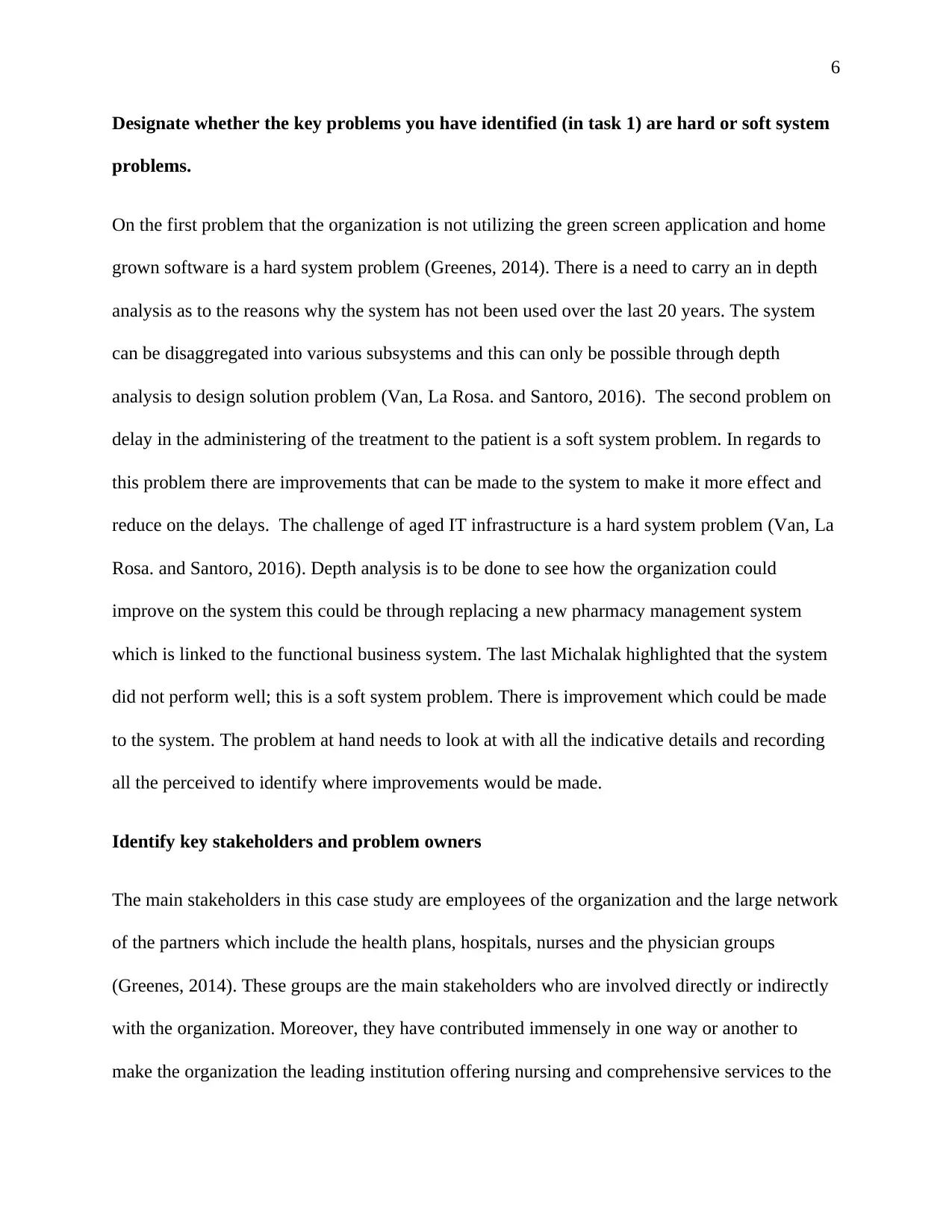
6
Designate whether the key problems you have identified (in task 1) are hard or soft system
problems.
On the first problem that the organization is not utilizing the green screen application and home
grown software is a hard system problem (Greenes, 2014). There is a need to carry an in depth
analysis as to the reasons why the system has not been used over the last 20 years. The system
can be disaggregated into various subsystems and this can only be possible through depth
analysis to design solution problem (Van, La Rosa. and Santoro, 2016). The second problem on
delay in the administering of the treatment to the patient is a soft system problem. In regards to
this problem there are improvements that can be made to the system to make it more effect and
reduce on the delays. The challenge of aged IT infrastructure is a hard system problem (Van, La
Rosa. and Santoro, 2016). Depth analysis is to be done to see how the organization could
improve on the system this could be through replacing a new pharmacy management system
which is linked to the functional business system. The last Michalak highlighted that the system
did not perform well; this is a soft system problem. There is improvement which could be made
to the system. The problem at hand needs to look at with all the indicative details and recording
all the perceived to identify where improvements would be made.
Identify key stakeholders and problem owners
The main stakeholders in this case study are employees of the organization and the large network
of the partners which include the health plans, hospitals, nurses and the physician groups
(Greenes, 2014). These groups are the main stakeholders who are involved directly or indirectly
with the organization. Moreover, they have contributed immensely in one way or another to
make the organization the leading institution offering nursing and comprehensive services to the
Designate whether the key problems you have identified (in task 1) are hard or soft system
problems.
On the first problem that the organization is not utilizing the green screen application and home
grown software is a hard system problem (Greenes, 2014). There is a need to carry an in depth
analysis as to the reasons why the system has not been used over the last 20 years. The system
can be disaggregated into various subsystems and this can only be possible through depth
analysis to design solution problem (Van, La Rosa. and Santoro, 2016). The second problem on
delay in the administering of the treatment to the patient is a soft system problem. In regards to
this problem there are improvements that can be made to the system to make it more effect and
reduce on the delays. The challenge of aged IT infrastructure is a hard system problem (Van, La
Rosa. and Santoro, 2016). Depth analysis is to be done to see how the organization could
improve on the system this could be through replacing a new pharmacy management system
which is linked to the functional business system. The last Michalak highlighted that the system
did not perform well; this is a soft system problem. There is improvement which could be made
to the system. The problem at hand needs to look at with all the indicative details and recording
all the perceived to identify where improvements would be made.
Identify key stakeholders and problem owners
The main stakeholders in this case study are employees of the organization and the large network
of the partners which include the health plans, hospitals, nurses and the physician groups
(Greenes, 2014). These groups are the main stakeholders who are involved directly or indirectly
with the organization. Moreover, they have contributed immensely in one way or another to
make the organization the leading institution offering nursing and comprehensive services to the
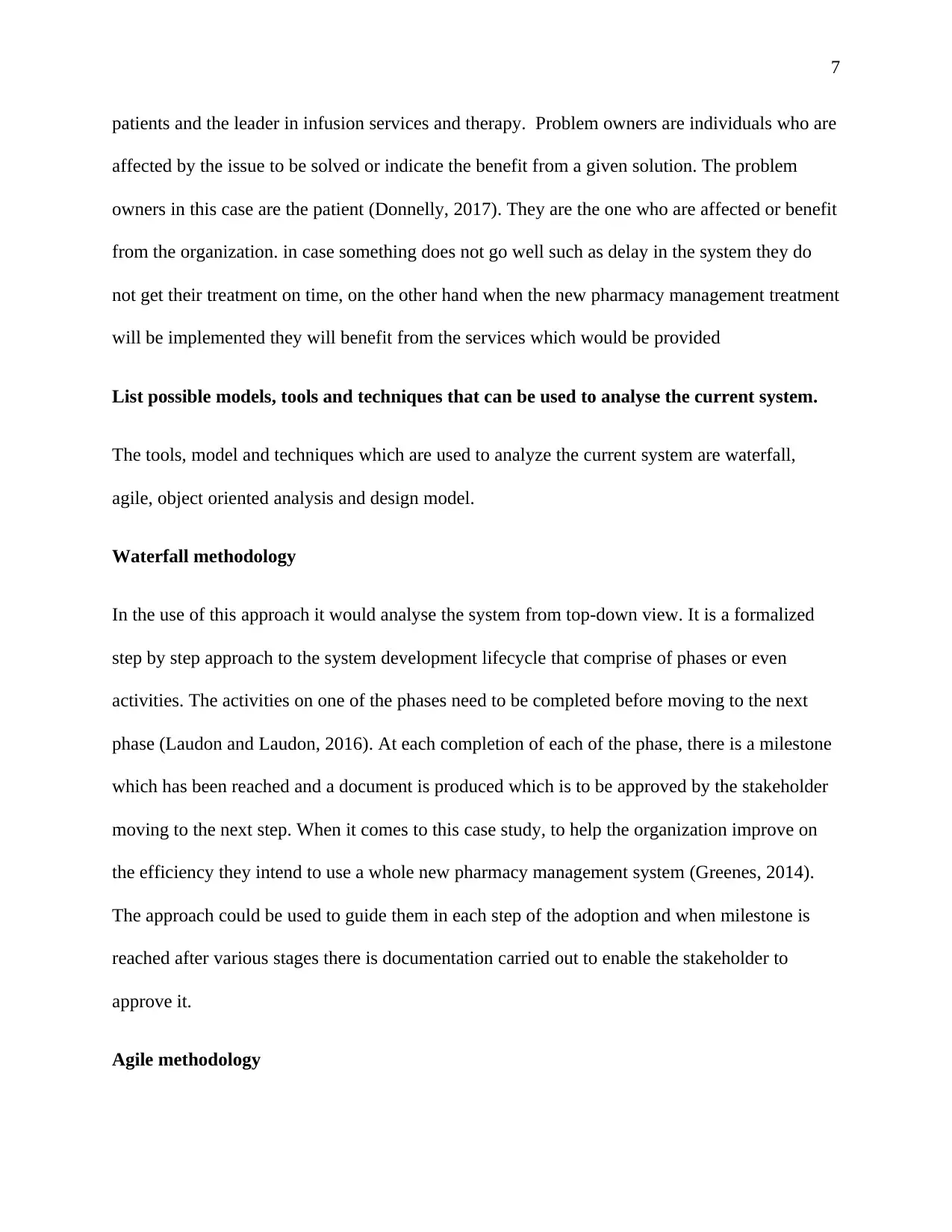
7
patients and the leader in infusion services and therapy. Problem owners are individuals who are
affected by the issue to be solved or indicate the benefit from a given solution. The problem
owners in this case are the patient (Donnelly, 2017). They are the one who are affected or benefit
from the organization. in case something does not go well such as delay in the system they do
not get their treatment on time, on the other hand when the new pharmacy management treatment
will be implemented they will benefit from the services which would be provided
List possible models, tools and techniques that can be used to analyse the current system.
The tools, model and techniques which are used to analyze the current system are waterfall,
agile, object oriented analysis and design model.
Waterfall methodology
In the use of this approach it would analyse the system from top-down view. It is a formalized
step by step approach to the system development lifecycle that comprise of phases or even
activities. The activities on one of the phases need to be completed before moving to the next
phase (Laudon and Laudon, 2016). At each completion of each of the phase, there is a milestone
which has been reached and a document is produced which is to be approved by the stakeholder
moving to the next step. When it comes to this case study, to help the organization improve on
the efficiency they intend to use a whole new pharmacy management system (Greenes, 2014).
The approach could be used to guide them in each step of the adoption and when milestone is
reached after various stages there is documentation carried out to enable the stakeholder to
approve it.
Agile methodology
patients and the leader in infusion services and therapy. Problem owners are individuals who are
affected by the issue to be solved or indicate the benefit from a given solution. The problem
owners in this case are the patient (Donnelly, 2017). They are the one who are affected or benefit
from the organization. in case something does not go well such as delay in the system they do
not get their treatment on time, on the other hand when the new pharmacy management treatment
will be implemented they will benefit from the services which would be provided
List possible models, tools and techniques that can be used to analyse the current system.
The tools, model and techniques which are used to analyze the current system are waterfall,
agile, object oriented analysis and design model.
Waterfall methodology
In the use of this approach it would analyse the system from top-down view. It is a formalized
step by step approach to the system development lifecycle that comprise of phases or even
activities. The activities on one of the phases need to be completed before moving to the next
phase (Laudon and Laudon, 2016). At each completion of each of the phase, there is a milestone
which has been reached and a document is produced which is to be approved by the stakeholder
moving to the next step. When it comes to this case study, to help the organization improve on
the efficiency they intend to use a whole new pharmacy management system (Greenes, 2014).
The approach could be used to guide them in each step of the adoption and when milestone is
reached after various stages there is documentation carried out to enable the stakeholder to
approve it.
Agile methodology
Paraphrase This Document
Need a fresh take? Get an instant paraphrase of this document with our AI Paraphraser
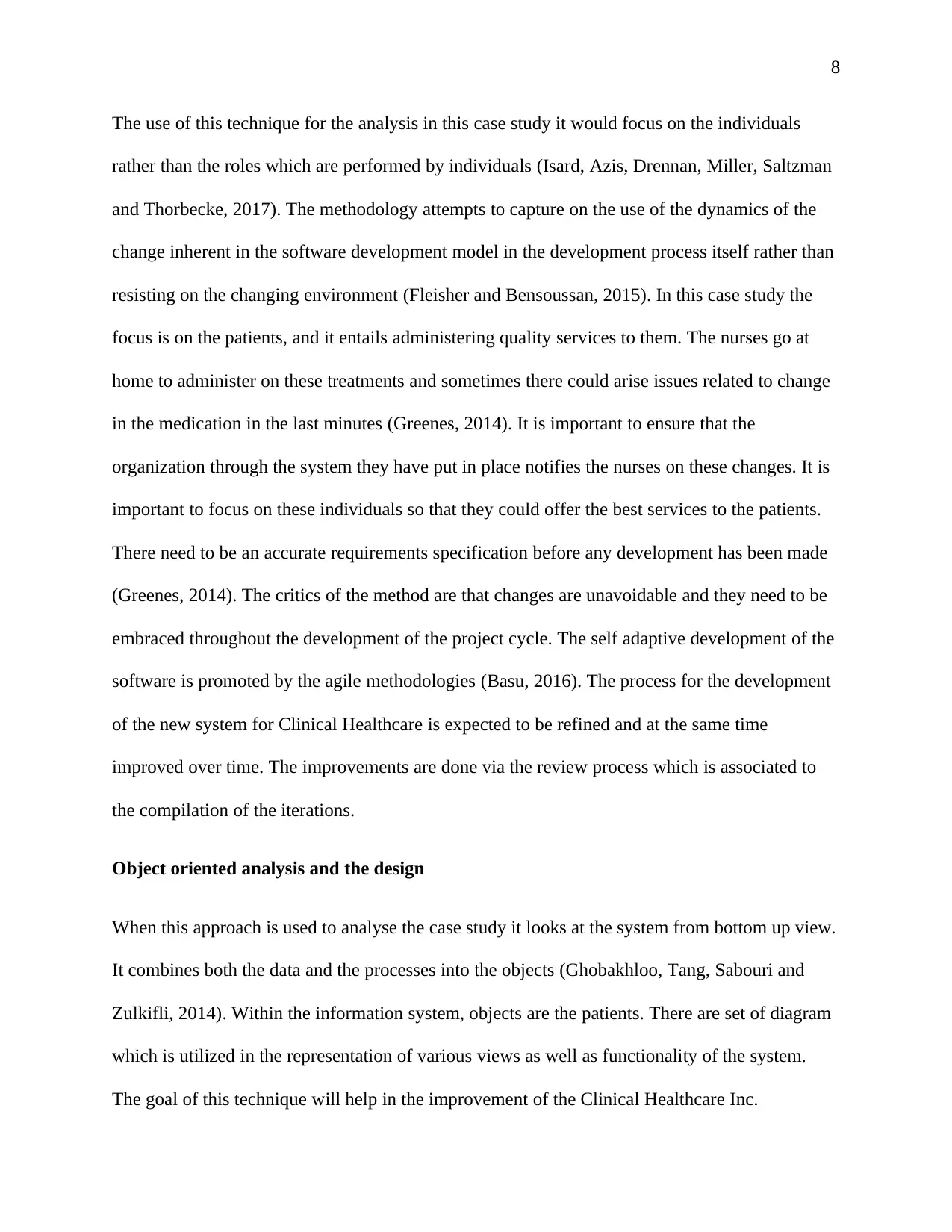
8
The use of this technique for the analysis in this case study it would focus on the individuals
rather than the roles which are performed by individuals (Isard, Azis, Drennan, Miller, Saltzman
and Thorbecke, 2017). The methodology attempts to capture on the use of the dynamics of the
change inherent in the software development model in the development process itself rather than
resisting on the changing environment (Fleisher and Bensoussan, 2015). In this case study the
focus is on the patients, and it entails administering quality services to them. The nurses go at
home to administer on these treatments and sometimes there could arise issues related to change
in the medication in the last minutes (Greenes, 2014). It is important to ensure that the
organization through the system they have put in place notifies the nurses on these changes. It is
important to focus on these individuals so that they could offer the best services to the patients.
There need to be an accurate requirements specification before any development has been made
(Greenes, 2014). The critics of the method are that changes are unavoidable and they need to be
embraced throughout the development of the project cycle. The self adaptive development of the
software is promoted by the agile methodologies (Basu, 2016). The process for the development
of the new system for Clinical Healthcare is expected to be refined and at the same time
improved over time. The improvements are done via the review process which is associated to
the compilation of the iterations.
Object oriented analysis and the design
When this approach is used to analyse the case study it looks at the system from bottom up view.
It combines both the data and the processes into the objects (Ghobakhloo, Tang, Sabouri and
Zulkifli, 2014). Within the information system, objects are the patients. There are set of diagram
which is utilized in the representation of various views as well as functionality of the system.
The goal of this technique will help in the improvement of the Clinical Healthcare Inc.
The use of this technique for the analysis in this case study it would focus on the individuals
rather than the roles which are performed by individuals (Isard, Azis, Drennan, Miller, Saltzman
and Thorbecke, 2017). The methodology attempts to capture on the use of the dynamics of the
change inherent in the software development model in the development process itself rather than
resisting on the changing environment (Fleisher and Bensoussan, 2015). In this case study the
focus is on the patients, and it entails administering quality services to them. The nurses go at
home to administer on these treatments and sometimes there could arise issues related to change
in the medication in the last minutes (Greenes, 2014). It is important to ensure that the
organization through the system they have put in place notifies the nurses on these changes. It is
important to focus on these individuals so that they could offer the best services to the patients.
There need to be an accurate requirements specification before any development has been made
(Greenes, 2014). The critics of the method are that changes are unavoidable and they need to be
embraced throughout the development of the project cycle. The self adaptive development of the
software is promoted by the agile methodologies (Basu, 2016). The process for the development
of the new system for Clinical Healthcare is expected to be refined and at the same time
improved over time. The improvements are done via the review process which is associated to
the compilation of the iterations.
Object oriented analysis and the design
When this approach is used to analyse the case study it looks at the system from bottom up view.
It combines both the data and the processes into the objects (Ghobakhloo, Tang, Sabouri and
Zulkifli, 2014). Within the information system, objects are the patients. There are set of diagram
which is utilized in the representation of various views as well as functionality of the system.
The goal of this technique will help in the improvement of the Clinical Healthcare Inc.
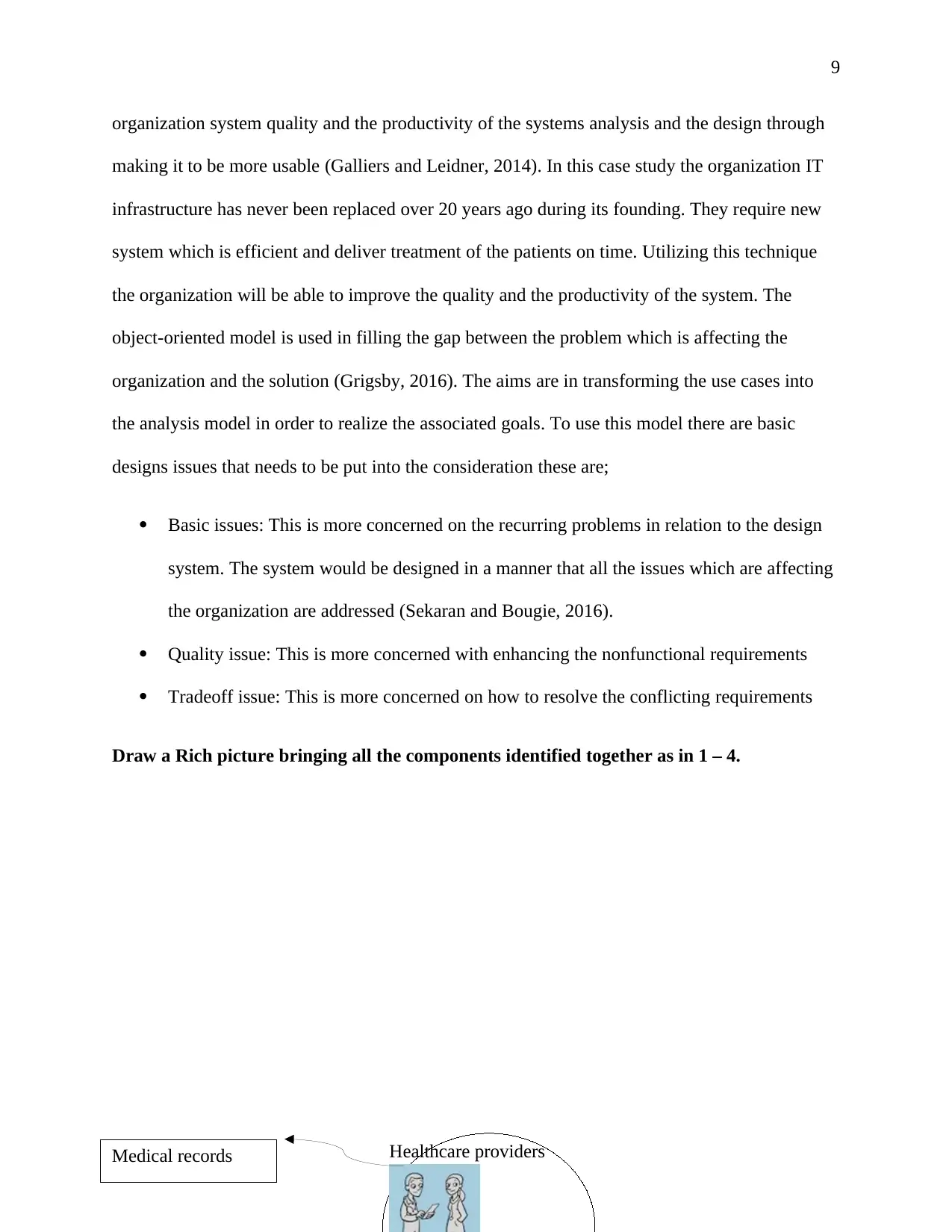
9
organization system quality and the productivity of the systems analysis and the design through
making it to be more usable (Galliers and Leidner, 2014). In this case study the organization IT
infrastructure has never been replaced over 20 years ago during its founding. They require new
system which is efficient and deliver treatment of the patients on time. Utilizing this technique
the organization will be able to improve the quality and the productivity of the system. The
object-oriented model is used in filling the gap between the problem which is affecting the
organization and the solution (Grigsby, 2016). The aims are in transforming the use cases into
the analysis model in order to realize the associated goals. To use this model there are basic
designs issues that needs to be put into the consideration these are;
Basic issues: This is more concerned on the recurring problems in relation to the design
system. The system would be designed in a manner that all the issues which are affecting
the organization are addressed (Sekaran and Bougie, 2016).
Quality issue: This is more concerned with enhancing the nonfunctional requirements
Tradeoff issue: This is more concerned on how to resolve the conflicting requirements
Draw a Rich picture bringing all the components identified together as in 1 – 4.
Healthcare providersMedical records
organization system quality and the productivity of the systems analysis and the design through
making it to be more usable (Galliers and Leidner, 2014). In this case study the organization IT
infrastructure has never been replaced over 20 years ago during its founding. They require new
system which is efficient and deliver treatment of the patients on time. Utilizing this technique
the organization will be able to improve the quality and the productivity of the system. The
object-oriented model is used in filling the gap between the problem which is affecting the
organization and the solution (Grigsby, 2016). The aims are in transforming the use cases into
the analysis model in order to realize the associated goals. To use this model there are basic
designs issues that needs to be put into the consideration these are;
Basic issues: This is more concerned on the recurring problems in relation to the design
system. The system would be designed in a manner that all the issues which are affecting
the organization are addressed (Sekaran and Bougie, 2016).
Quality issue: This is more concerned with enhancing the nonfunctional requirements
Tradeoff issue: This is more concerned on how to resolve the conflicting requirements
Draw a Rich picture bringing all the components identified together as in 1 – 4.
Healthcare providersMedical records
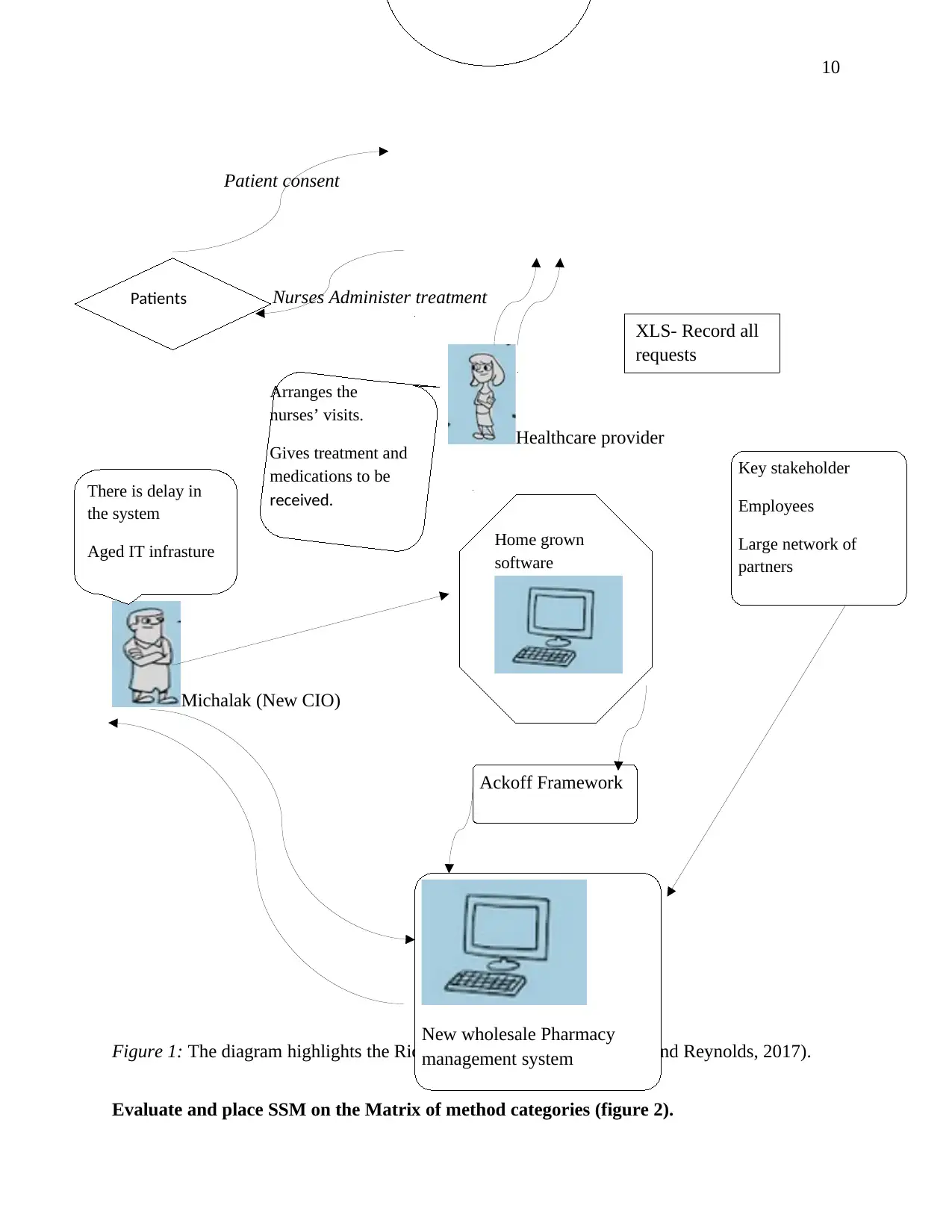
10
Patient consent
Dddddddddddd Nurses Administer treatment
Healthcare provider
Michalak (New CIO)
F
Figure 1: The diagram highlights the Rich picture of components (Stair and Reynolds, 2017).
Evaluate and place SSM on the Matrix of method categories (figure 2).
Patients
Home grown
software
XLS- Record all
requests
Arranges the
nurses’ visits.
Gives treatment and
medications to be
received.
There is delay in
the system
Aged IT infrasture
Key stakeholder
Employees
Large network of
partners
New wholesale Pharmacy
management system
Ackoff Framework
Patient consent
Dddddddddddd Nurses Administer treatment
Healthcare provider
Michalak (New CIO)
F
Figure 1: The diagram highlights the Rich picture of components (Stair and Reynolds, 2017).
Evaluate and place SSM on the Matrix of method categories (figure 2).
Patients
Home grown
software
XLS- Record all
requests
Arranges the
nurses’ visits.
Gives treatment and
medications to be
received.
There is delay in
the system
Aged IT infrasture
Key stakeholder
Employees
Large network of
partners
New wholesale Pharmacy
management system
Ackoff Framework
Secure Best Marks with AI Grader
Need help grading? Try our AI Grader for instant feedback on your assignments.
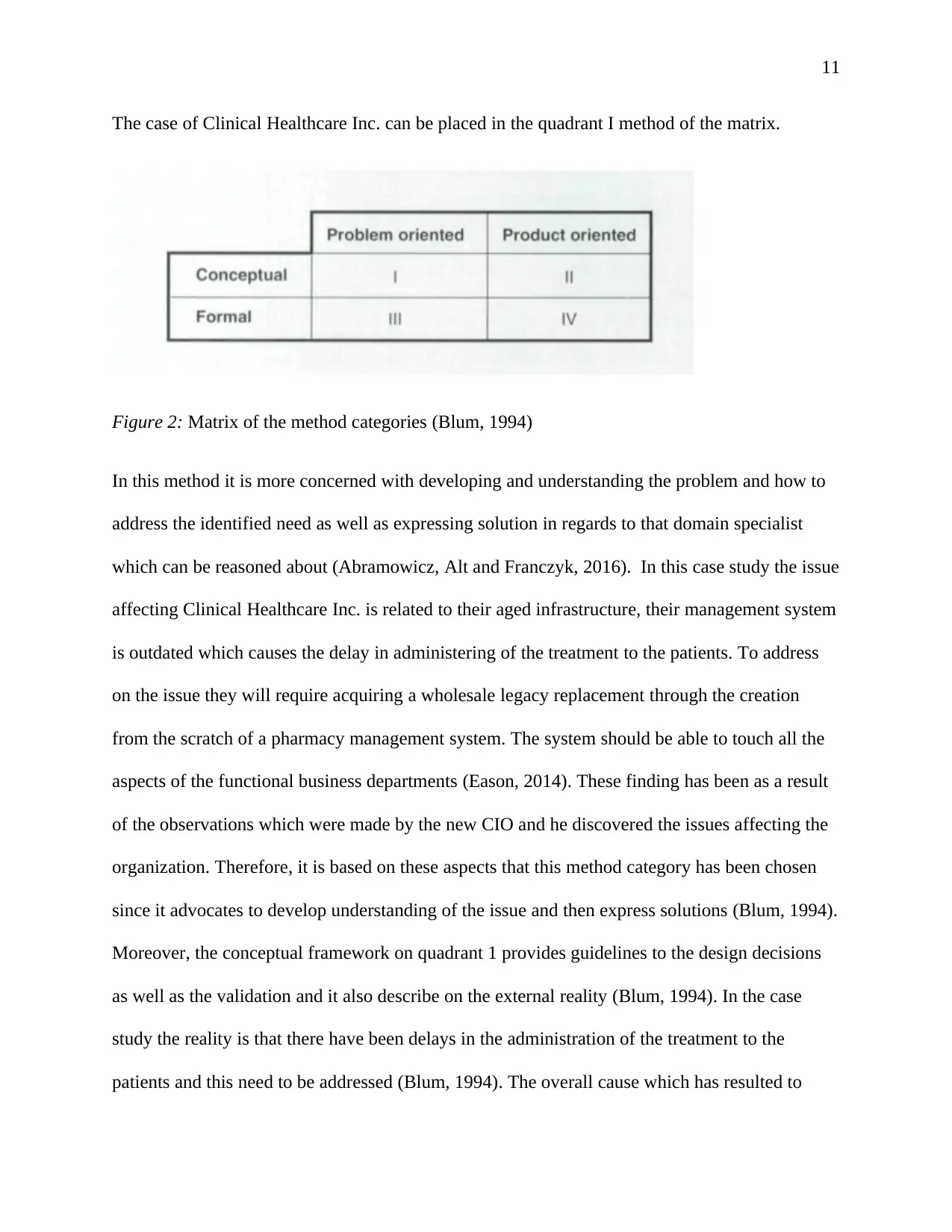
11
The case of Clinical Healthcare Inc. can be placed in the quadrant I method of the matrix.
Figure 2: Matrix of the method categories (Blum, 1994)
In this method it is more concerned with developing and understanding the problem and how to
address the identified need as well as expressing solution in regards to that domain specialist
which can be reasoned about (Abramowicz, Alt and Franczyk, 2016). In this case study the issue
affecting Clinical Healthcare Inc. is related to their aged infrastructure, their management system
is outdated which causes the delay in administering of the treatment to the patients. To address
on the issue they will require acquiring a wholesale legacy replacement through the creation
from the scratch of a pharmacy management system. The system should be able to touch all the
aspects of the functional business departments (Eason, 2014). These finding has been as a result
of the observations which were made by the new CIO and he discovered the issues affecting the
organization. Therefore, it is based on these aspects that this method category has been chosen
since it advocates to develop understanding of the issue and then express solutions (Blum, 1994).
Moreover, the conceptual framework on quadrant 1 provides guidelines to the design decisions
as well as the validation and it also describe on the external reality (Blum, 1994). In the case
study the reality is that there have been delays in the administration of the treatment to the
patients and this need to be addressed (Blum, 1994). The overall cause which has resulted to
The case of Clinical Healthcare Inc. can be placed in the quadrant I method of the matrix.
Figure 2: Matrix of the method categories (Blum, 1994)
In this method it is more concerned with developing and understanding the problem and how to
address the identified need as well as expressing solution in regards to that domain specialist
which can be reasoned about (Abramowicz, Alt and Franczyk, 2016). In this case study the issue
affecting Clinical Healthcare Inc. is related to their aged infrastructure, their management system
is outdated which causes the delay in administering of the treatment to the patients. To address
on the issue they will require acquiring a wholesale legacy replacement through the creation
from the scratch of a pharmacy management system. The system should be able to touch all the
aspects of the functional business departments (Eason, 2014). These finding has been as a result
of the observations which were made by the new CIO and he discovered the issues affecting the
organization. Therefore, it is based on these aspects that this method category has been chosen
since it advocates to develop understanding of the issue and then express solutions (Blum, 1994).
Moreover, the conceptual framework on quadrant 1 provides guidelines to the design decisions
as well as the validation and it also describe on the external reality (Blum, 1994). In the case
study the reality is that there have been delays in the administration of the treatment to the
patients and this need to be addressed (Blum, 1994). The overall cause which has resulted to
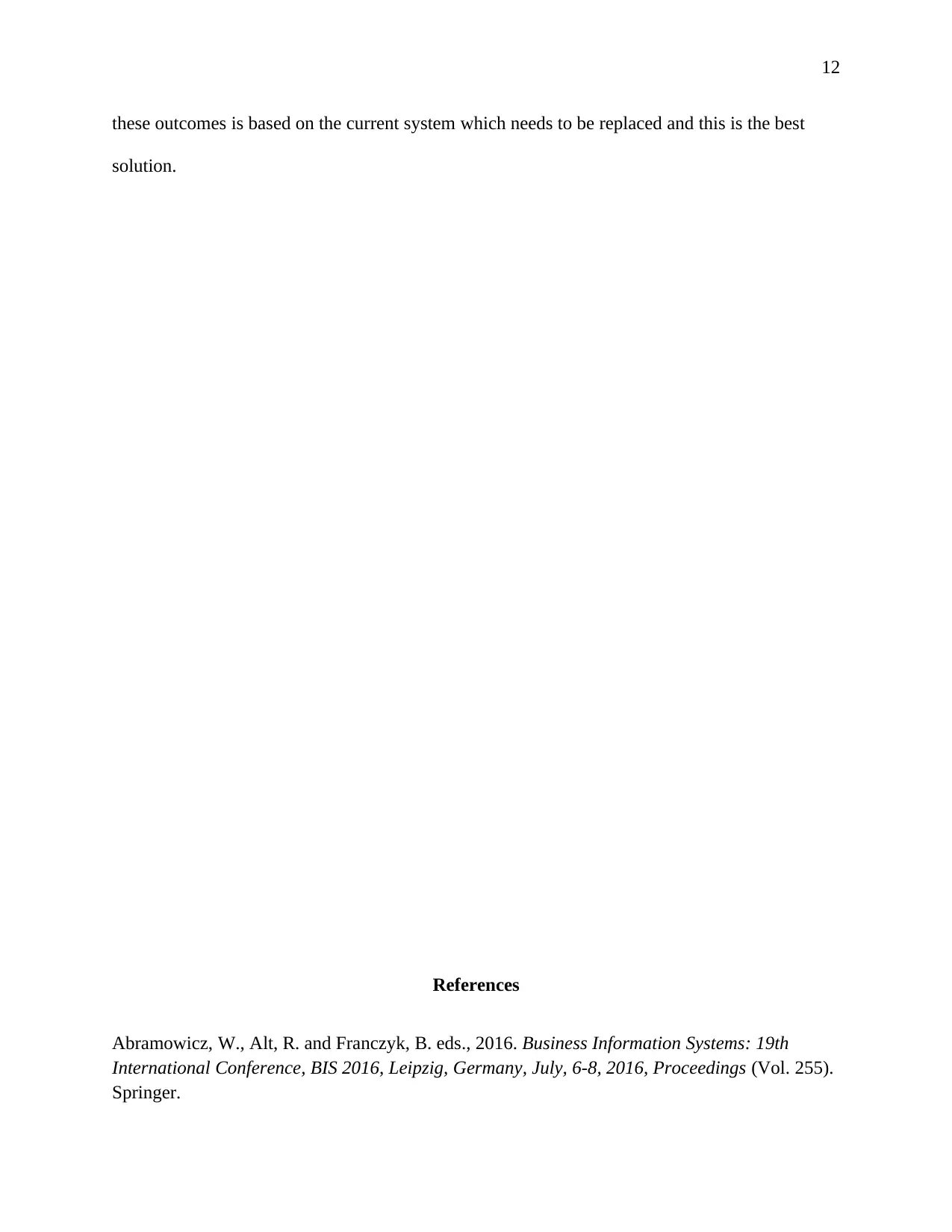
12
these outcomes is based on the current system which needs to be replaced and this is the best
solution.
References
Abramowicz, W., Alt, R. and Franczyk, B. eds., 2016. Business Information Systems: 19th
International Conference, BIS 2016, Leipzig, Germany, July, 6-8, 2016, Proceedings (Vol. 255).
Springer.
these outcomes is based on the current system which needs to be replaced and this is the best
solution.
References
Abramowicz, W., Alt, R. and Franczyk, B. eds., 2016. Business Information Systems: 19th
International Conference, BIS 2016, Leipzig, Germany, July, 6-8, 2016, Proceedings (Vol. 255).
Springer.
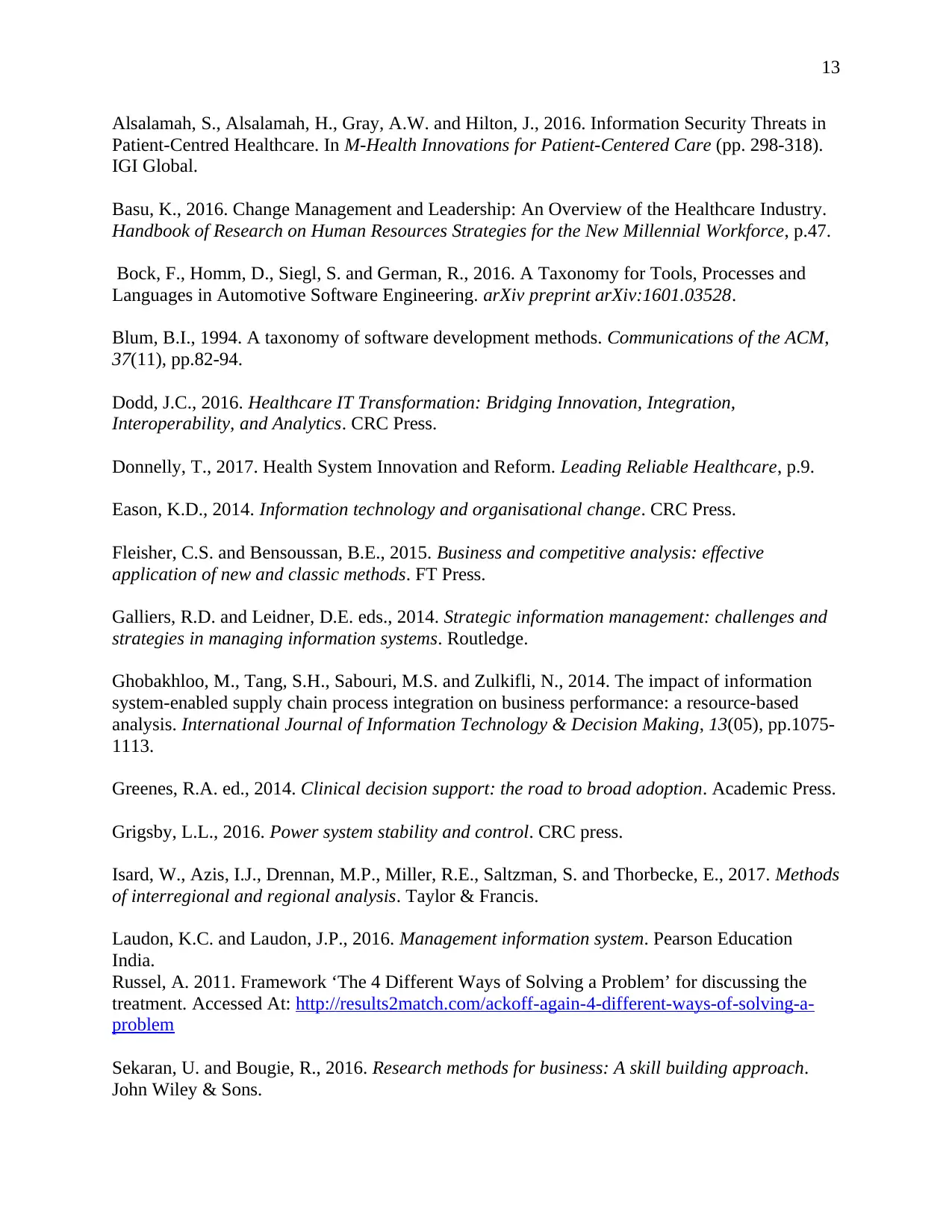
13
Alsalamah, S., Alsalamah, H., Gray, A.W. and Hilton, J., 2016. Information Security Threats in
Patient-Centred Healthcare. In M-Health Innovations for Patient-Centered Care (pp. 298-318).
IGI Global.
Basu, K., 2016. Change Management and Leadership: An Overview of the Healthcare Industry.
Handbook of Research on Human Resources Strategies for the New Millennial Workforce, p.47.
Bock, F., Homm, D., Siegl, S. and German, R., 2016. A Taxonomy for Tools, Processes and
Languages in Automotive Software Engineering. arXiv preprint arXiv:1601.03528.
Blum, B.I., 1994. A taxonomy of software development methods. Communications of the ACM,
37(11), pp.82-94.
Dodd, J.C., 2016. Healthcare IT Transformation: Bridging Innovation, Integration,
Interoperability, and Analytics. CRC Press.
Donnelly, T., 2017. Health System Innovation and Reform. Leading Reliable Healthcare, p.9.
Eason, K.D., 2014. Information technology and organisational change. CRC Press.
Fleisher, C.S. and Bensoussan, B.E., 2015. Business and competitive analysis: effective
application of new and classic methods. FT Press.
Galliers, R.D. and Leidner, D.E. eds., 2014. Strategic information management: challenges and
strategies in managing information systems. Routledge.
Ghobakhloo, M., Tang, S.H., Sabouri, M.S. and Zulkifli, N., 2014. The impact of information
system-enabled supply chain process integration on business performance: a resource-based
analysis. International Journal of Information Technology & Decision Making, 13(05), pp.1075-
1113.
Greenes, R.A. ed., 2014. Clinical decision support: the road to broad adoption. Academic Press.
Grigsby, L.L., 2016. Power system stability and control. CRC press.
Isard, W., Azis, I.J., Drennan, M.P., Miller, R.E., Saltzman, S. and Thorbecke, E., 2017. Methods
of interregional and regional analysis. Taylor & Francis.
Laudon, K.C. and Laudon, J.P., 2016. Management information system. Pearson Education
India.
Russel, A. 2011. Framework ‘The 4 Different Ways of Solving a Problem’ for discussing the
treatment. Accessed At: http://results2match.com/ackoff-again-4-different-ways-of-solving-a-
problem
Sekaran, U. and Bougie, R., 2016. Research methods for business: A skill building approach.
John Wiley & Sons.
Alsalamah, S., Alsalamah, H., Gray, A.W. and Hilton, J., 2016. Information Security Threats in
Patient-Centred Healthcare. In M-Health Innovations for Patient-Centered Care (pp. 298-318).
IGI Global.
Basu, K., 2016. Change Management and Leadership: An Overview of the Healthcare Industry.
Handbook of Research on Human Resources Strategies for the New Millennial Workforce, p.47.
Bock, F., Homm, D., Siegl, S. and German, R., 2016. A Taxonomy for Tools, Processes and
Languages in Automotive Software Engineering. arXiv preprint arXiv:1601.03528.
Blum, B.I., 1994. A taxonomy of software development methods. Communications of the ACM,
37(11), pp.82-94.
Dodd, J.C., 2016. Healthcare IT Transformation: Bridging Innovation, Integration,
Interoperability, and Analytics. CRC Press.
Donnelly, T., 2017. Health System Innovation and Reform. Leading Reliable Healthcare, p.9.
Eason, K.D., 2014. Information technology and organisational change. CRC Press.
Fleisher, C.S. and Bensoussan, B.E., 2015. Business and competitive analysis: effective
application of new and classic methods. FT Press.
Galliers, R.D. and Leidner, D.E. eds., 2014. Strategic information management: challenges and
strategies in managing information systems. Routledge.
Ghobakhloo, M., Tang, S.H., Sabouri, M.S. and Zulkifli, N., 2014. The impact of information
system-enabled supply chain process integration on business performance: a resource-based
analysis. International Journal of Information Technology & Decision Making, 13(05), pp.1075-
1113.
Greenes, R.A. ed., 2014. Clinical decision support: the road to broad adoption. Academic Press.
Grigsby, L.L., 2016. Power system stability and control. CRC press.
Isard, W., Azis, I.J., Drennan, M.P., Miller, R.E., Saltzman, S. and Thorbecke, E., 2017. Methods
of interregional and regional analysis. Taylor & Francis.
Laudon, K.C. and Laudon, J.P., 2016. Management information system. Pearson Education
India.
Russel, A. 2011. Framework ‘The 4 Different Ways of Solving a Problem’ for discussing the
treatment. Accessed At: http://results2match.com/ackoff-again-4-different-ways-of-solving-a-
problem
Sekaran, U. and Bougie, R., 2016. Research methods for business: A skill building approach.
John Wiley & Sons.
Paraphrase This Document
Need a fresh take? Get an instant paraphrase of this document with our AI Paraphraser
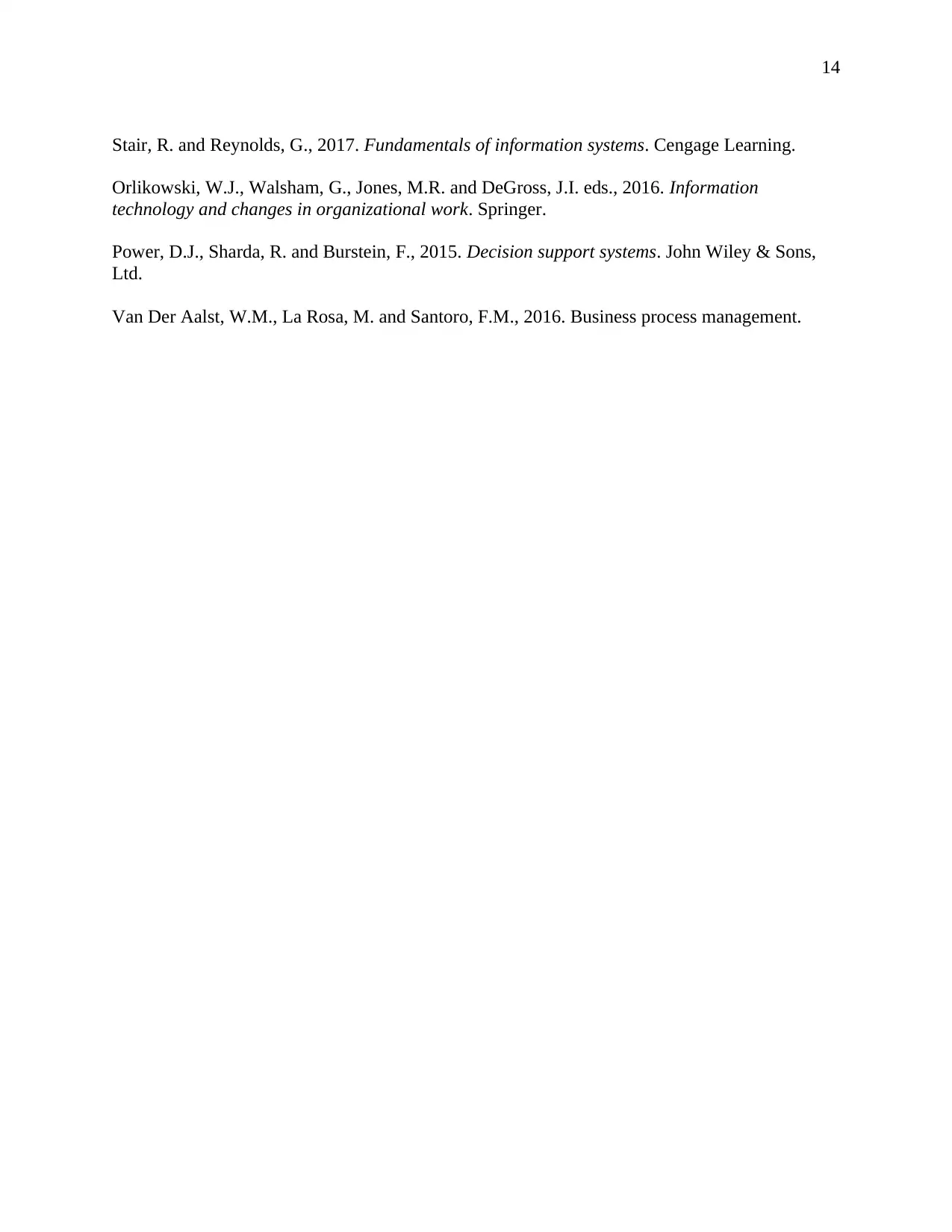
14
Stair, R. and Reynolds, G., 2017. Fundamentals of information systems. Cengage Learning.
Orlikowski, W.J., Walsham, G., Jones, M.R. and DeGross, J.I. eds., 2016. Information
technology and changes in organizational work. Springer.
Power, D.J., Sharda, R. and Burstein, F., 2015. Decision support systems. John Wiley & Sons,
Ltd.
Van Der Aalst, W.M., La Rosa, M. and Santoro, F.M., 2016. Business process management.
Stair, R. and Reynolds, G., 2017. Fundamentals of information systems. Cengage Learning.
Orlikowski, W.J., Walsham, G., Jones, M.R. and DeGross, J.I. eds., 2016. Information
technology and changes in organizational work. Springer.
Power, D.J., Sharda, R. and Burstein, F., 2015. Decision support systems. John Wiley & Sons,
Ltd.
Van Der Aalst, W.M., La Rosa, M. and Santoro, F.M., 2016. Business process management.
1 out of 14
Related Documents
Your All-in-One AI-Powered Toolkit for Academic Success.
+13062052269
info@desklib.com
Available 24*7 on WhatsApp / Email
![[object Object]](/_next/static/media/star-bottom.7253800d.svg)
Unlock your academic potential
© 2024 | Zucol Services PVT LTD | All rights reserved.





